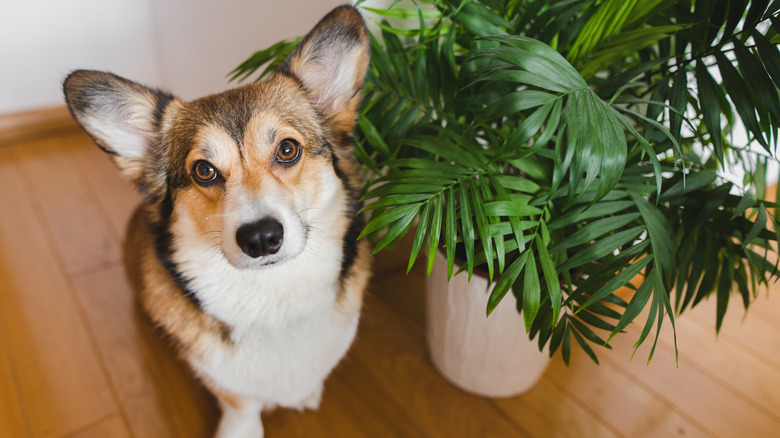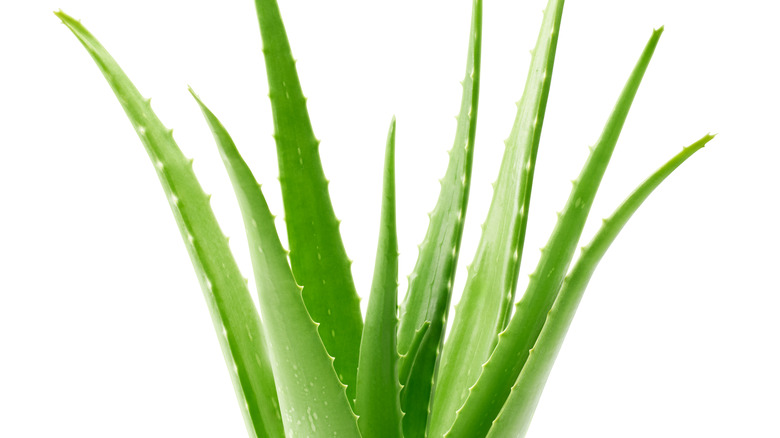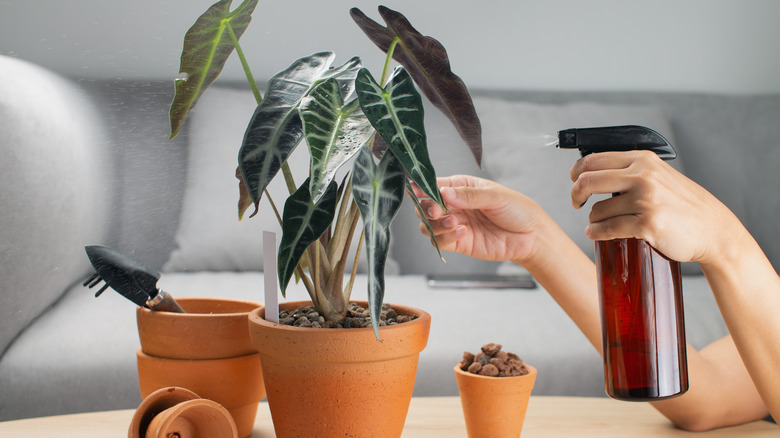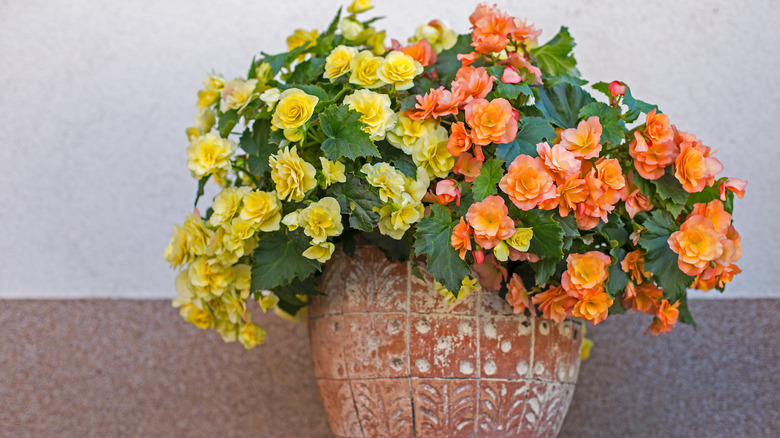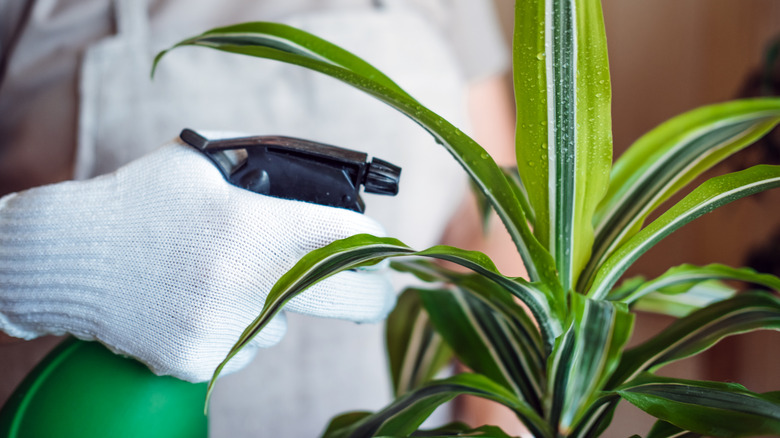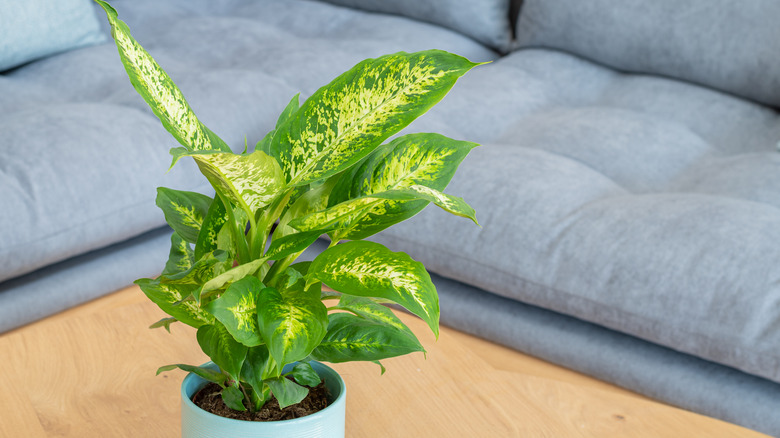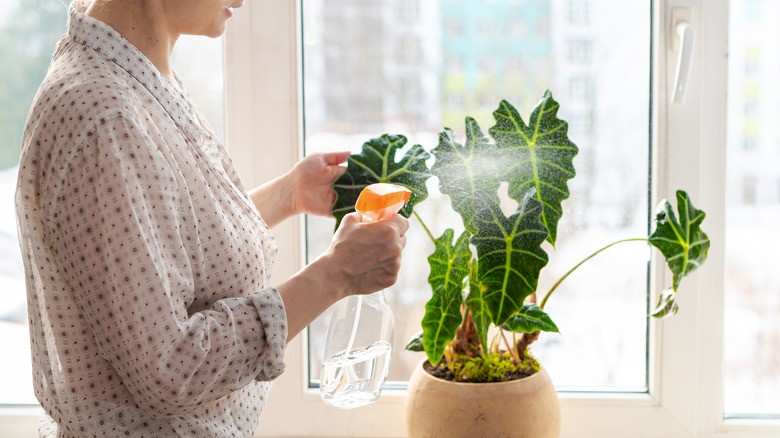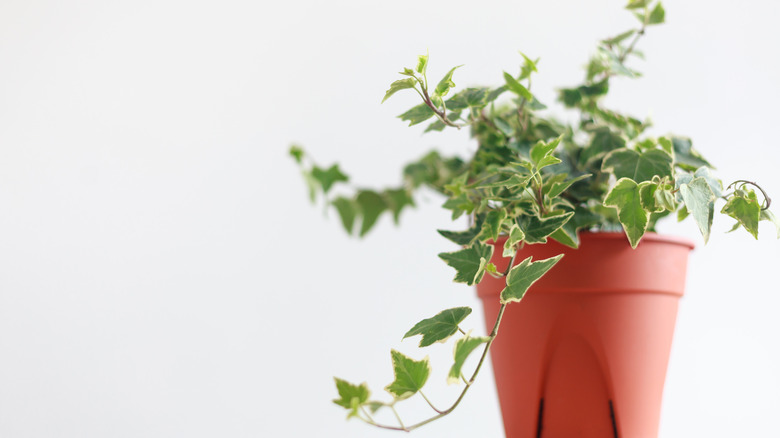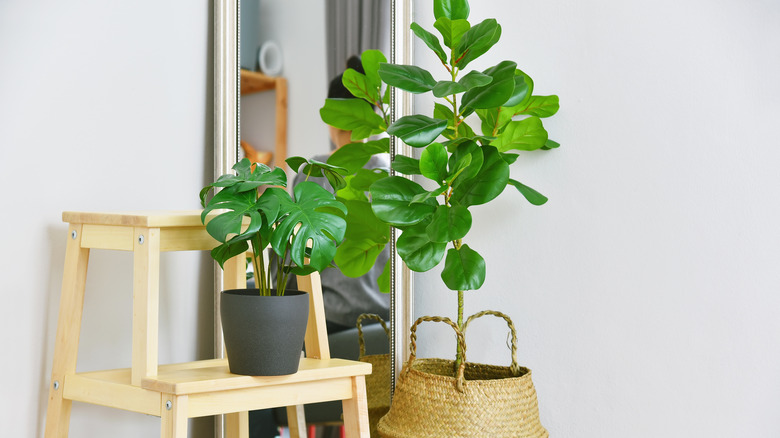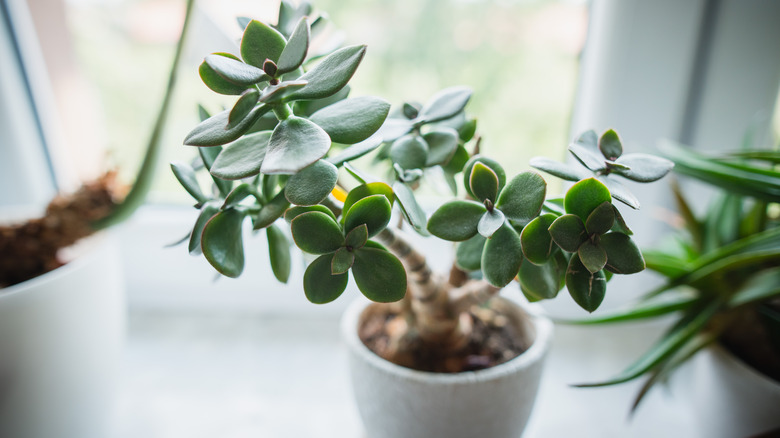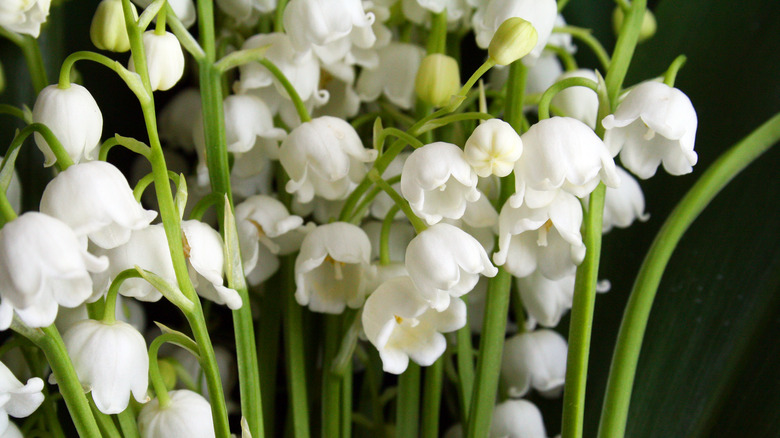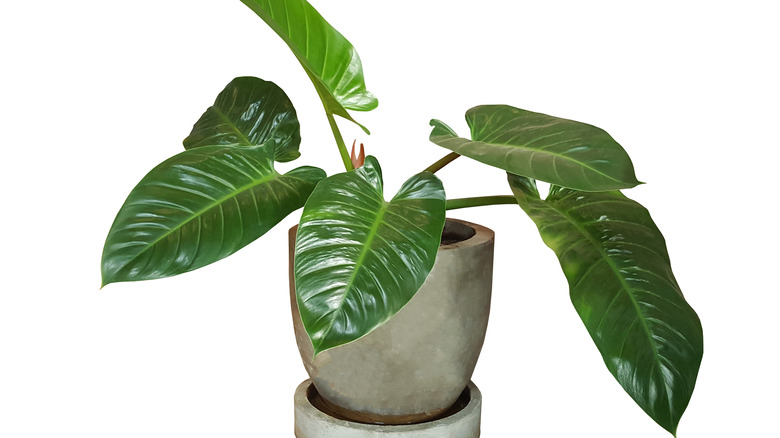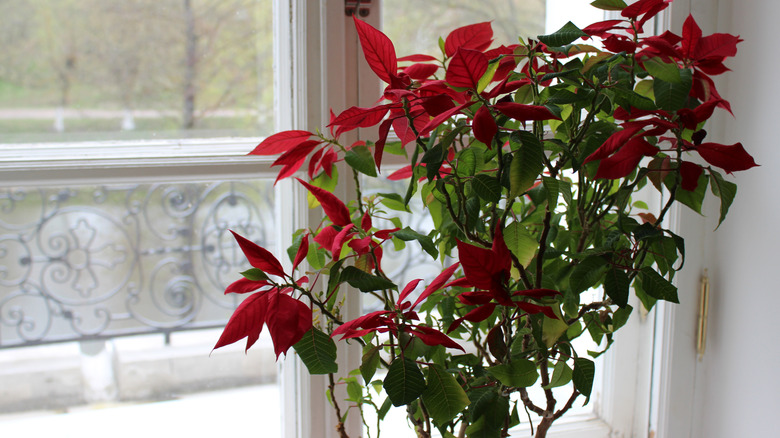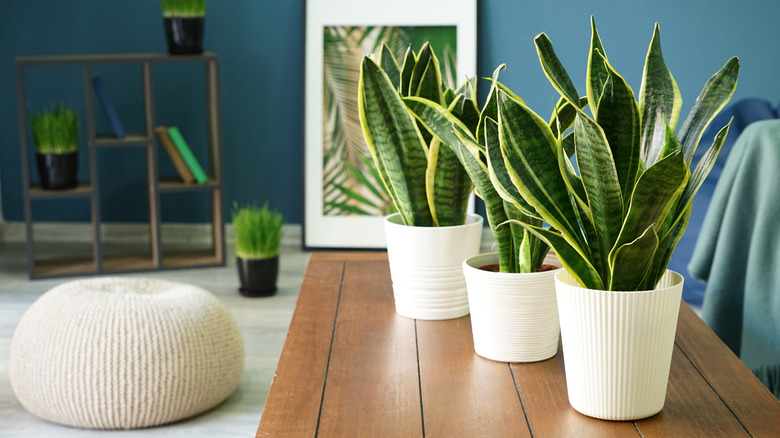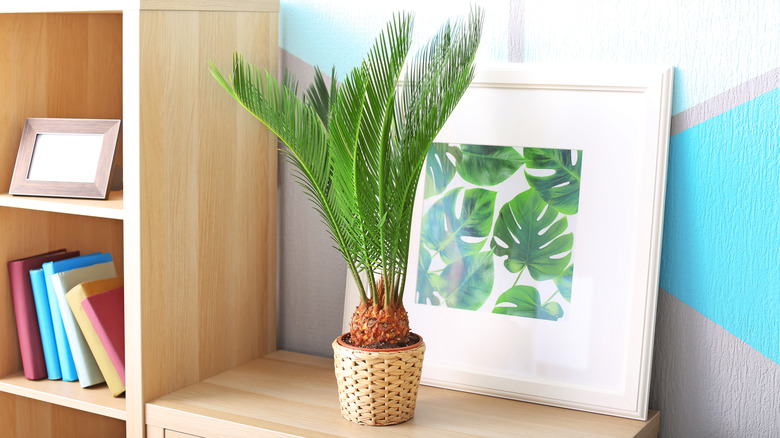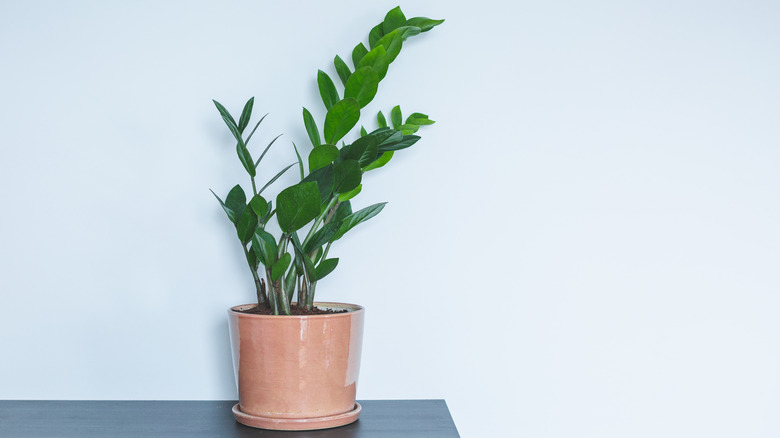15 Popular Houseplants That Are Actually Toxic To Dogs
More than 233,000 animals are poisoned each year, and 6% of those occur because a pet consumed some sort of plant toxins, said Canine Journal, quoting the ASPCA. While that's not a huge percentage, owners should watch out for their furry friends when selecting their houseplants. Some types you might want to forego, while others should find spots away from Fido. Some plants are lethal while others can cause things like rapid breathing, diarrhea, excessive drooling, lethargy, irregular pulse, vomiting, and other ailments. Your pet's size and how much toxin ingested determine the severity of the symptoms. Cardiotoxic plants like lily of the valley, hyacinth, hydrangea, rhododendron, oleander, foxglove, and azalea can weaken the heart and are dangerous to your dog. Luckily, most of these stay in outside gardens, but become wary of where you display those pretty bouquets and holiday-potted plants.
Unfortunately, pets like to nibble on plants — the smell, texture, or taste can appeal to them. Additionally, some animals (and people, too!) have pica, a condition where they want to consume things outside conventional food items that offer no nutritional value, said Daily Paws. Being careful can keep your pooch safe and help your wallet. According to Centenary University, which quoted Nationwide Insurance, the treatment for plant toxicity costs an average of $547 — and there are more than 700 plants with a substance that can hurt your pet. Here are 15 popular houseplants to include on your "be careful" starter checklist.
1. Aloe
We love keeping this succulent around because aloe (Aloe) comes in handy for all those skin scrapes and mild burns. Aloe is not dog friendly, though, because it contains saponins and anthraquinones, which can cause your pet perils like vomiting, diarrhea, exhaustion, and more, said Reader's Digest. So keep this away from your dog — maybe in a bay window or on a kitchen shelf.
The good news about the plant is it's easy to keep healthy. Aloe likes indirect sunlight since beaming rays can dry it out, according to The Old Farmer's Almanac. If you put the plant in a sunny spot, be sure to water it more often. Soil should always be moist, but not saturated or the roots might rot.
2. Alocasia
The alocasia (Alocasia macrorrhizos) makes a striking houseplant with its deep green leaves and veins etched in stark white. It is part of the Araceae family that has 79 species originating from a variety of places, including the eastern Himalayas and eastern Australia. If your dog eats the leaves, stems, or roots, however, the plant can hurt Fido. The insoluble calcium oxalates it contains causes the tongue to burn, invokes vomiting and can make it difficult to swallow, according to Balcony Garden Web.
Put the plant somewhere your pooch can't reach and make sure the spot has bright, indirect light, as direct sunlight can make alocasia leaves burn. Avoid the space around the air conditioner and heater as well — alocasia enjoys humid atmospheres best (via Greenery Unlimited).
3. Begonia
You'll see begonias (begonia) in containers a lot, and the beautiful blossoms might tempt you to bring it home. Resist, though, because begonias can cause oral irritation and trouble swallowing in your dog if the pooch consumes it and the calcium oxalate it contains, according to the American Kennel Club.
Begonias are often grown outdoors, but there are several varieties that do well indoors and will produce spectacular leaves, such as cane begonias with their teardrop greenery. Besides putting Begonias in a space your dog won't find, you'll need indirect sunlight or its leaves might burn. Finding the right balance with watering might provide a challenge since the plant doesn't appreciate too much of the H20. Strive for slightly damp soil, as noted by Apartment Therapy.
4. Corn plant
The corn plant (dracaena fragrans) has steroidal saponin in it. When eaten, this substance can cause your dog to vomit — occasionally including blood. Your pooch might even lose its appetite or become depressed, according to Rover.
These plants grow 4 to 6 feet, perfect for containers on the floor. So make sure you place these in a room with a closed door or on a stand so your dog cannot reach it. Corn plants thrive is spaces with bright, indirect light away from the air conditioner, heating system, and any drafts, said The Spruce. The plant likes a temperature of 60 to 75 degrees Fahrenheit.
5. Dumb Cane
There are some serious consequences that come with gnawing on dumb cane (dieffenbachia), according to American Humane, such as renal failure, an uneven heat beat, cardiac shock, and death. The deep green leaves with white stripes and spots are visually appealing, but they contain calcium oxalate crystals, which can burn your pooch's mouth, tongue, and lips — or worse, according to Be Chewy.
The dumb cane makes a terrific office plant — away from your dog — because of its pretty leaves. The plant likes moist soil, but don't overwater it, according to Gardening Know How. You want filtered lighting so sheer curtains or partial blinds that keep the sunlight indirect work well. If the plant starts leaning towards the window, be sure to turn it.
6. Elephant Ear
Elephant ear (caladium) can cause a bit of trouble if your doggie decides to lunch on it. These popular houseplants contain insoluble calcium oxalate crystals, according to Newsweek. So if your pooch chews or bites on the stems, the toxic crystals release and your pet might experience oral irritation like burning, vomiting, drooling, and even swelling of the airway — which will make it hard for your dog to breathe.
These exotic looking plants need direct sun or partial shade, said Gardenia. Don't let the soil stay dry, though, as regular watering will keep the leaves looking lush.
7. English Ivy
While this vining plant looks lovely hanging from a planter, English Ivy (hedera helix), can hurt your happy hound. Actually, lots of popular ivy plants, including golden pothos, have toxins that can cause your animal mild distress when consumed, said Every Day. Your pet might feel stomach and mouth irritation, excessive salvation, oral swelling, vomiting, or more. That's because the plant has a natural steroid called sapogenin that also includes polyacetylene compounds, according to Wag!
Ivies do not like when you overwater them. So besides placing this houseplant up high to avoid your pooch's ever-present hunger, wait until the soil is slightly dry before bringing out the watering can, according to Costa Farms. You'll also want medium bright light for it to thrive.
8. Fiddle Leaf Fig
The fiddle leaf fig (ficus lyrata) has a thin trunk and leaves shaped like, well, fiddles. It is loved by interior decorators, but not by pet owners; if your dog eats this fun plant, it can cause painful skin irritations and gastro distress due to the insoluble calcium oxalates it contains, reported The Spruce.
Caring for the fiddle leaf fig isn't always easy: it likes humidity, lots of light, and regular waterings. You should think about putting the plant next to a window (away from Rover) so it gets the more than six hours of light it needs, advised Greenery Unlimited. You'll also want to rotate it once a month or so to prevent it leaning towards the sunlight.
9. Jade plant
Known by many names — jade tree, dwarf rubber plant, Chinese or Japanese rubber plant, friendship tree, and baby jade, whew!) — the jade plant (crassula ovata) is not to be eaten by your dog. The toxins it possesses are actually a mystery, but whatever they are will cause vomiting, lack of coordination, bradycardia (a slow heart rate), and even depression, said the Weddington Animal Hospital.
The jade plant looks much like its namesake gemstone and to keep the sheen on its leaves you'll need to place it in direct light and avoid overwatering. It actually likes slightly dry soil, according to Plant Care Today.
10. Lily
All lilies are lovely, but many of them are also poisonous to our furry friends. Some like the lily of the valley (convallaria majalis) are quite dangerous and can cause the heart rate to drop — and even cardiac arrest. Daylilies (hemerocallis), while exceedingly toxic to cats usually only give Fido a stomachache. Calla lilies (zantedeschia aethiopica) can mildly (or sometimes severely) irritate a dog's stomach and mouth, per the American Kennel Club. And the peace lily (spathiphyllum) provides little respite if consumed; instead your dog might vomit or have issues swallowing, according to the Weddington Animal Hospital. Moral of the story: Be careful with lilies in your home. It's a good idea to keep all out of reach.
While many plants claim to be a lily, not all are part of the Lilium genus. For instance, daylilies look like one, but they aren't considered "true lilies," according to The Old Farmer's Almanac, which typically have just one stem and grow from a bulb. Care may vary, depending on the variety. For example, the peace lily requires moist soil, which means a once-a-week watering, according to Lively Root. If you use tap water, let it sit out for 24 hours so the chlorine has time to evaporate; the plant dislikes chemicals.
11. Philodendron
The whole family of philodendron plants (philodendron), including the Swiss cheese plant, heartleaf, and fiddle-leaf versions can be mild or moderately toxic to your doggie, according to Every Day. That's because it has insoluable calcium oxalates, according to The Spruce. If your pet snacks on any of these, the animal will experience oral pain and swelling, vomiting, and might have trouble swallowing.
You'll want to offer this plant a location with bright, indirect sunlight — away from your pet's jaws— and you want the soil to dry slightly between waterings, according to Garden Know How. If the leaves droop, up the water. Philodendrons also benefit from occasional fertilizer — say, monthly in the warmer months and every six to eight weeks when the weather turns cooler.
12. Poinsettia
We all enjoy our holiday decorations, but if your pooch eats the poinsettia (Euphorbia pulcherrima) off a low table, the pet won't be celebrating. These festive plants contain a white sap that when consumed causes vomiting, drooling, and diarrhea in dogs, according to the American Kennel Club. Skin that touches the substance can also become irritated. The good news is that the poinsettia is only mildly toxic and if you take precautions, you can avoid this scenario entirely.
House Beautiful advised that poinsettias don't like overwatering. Shoot for a happy medium where the soil isn't dry or saturated. The plant likes a warmish environment so near the radiator can work. So after the holiday, feel free to keep your plant for next year — with the right care it might just bloom again.
13. Snake plant
Snake plants (sansevieria trifasciata) — with their green spikes rising upward like a striking snake — need little attention, make them a popular indoor plant. Yet, this visually alluring plant contain saponins, which won't mix well with your dog, according to Reader's Digest. Some side effects of consuming it include vomiting, diarrhea, and nausea.
In terms of care, though, snake plants are a dream. While you need to provide a light source — they grow more quickly with a bright, natural glow — a lower light level will still satisfy the plant, although it will expand more slowly, according to Joy Us Garden. With watering, you want to let the soil dry out before replenishing it with H20; that can mean every two to eight weeks, depending on the environment, pot size, placement, etc.
14. Sago palm
The leafy, easy-to-grow sago palm (cycas revolute) is a popular indoor (and outdoor) plant ... but it's not perfect for dog owners since it possesses cycasin. "If consumed by your dog, the sago palm causes severe vomiting, diarrhea, and abdominal pain, as well as stumbling, tremors, seizures, and temperature-regulation issues," said Dr. Christie Long, head of veterinary medicine at Modern Animal in West Hollywood, California, to Reader's Digest. "Ultimately, it causes liver failure, and death can occur with ingestion of an amount as small as a single seed."
So, this plant might fare better in an office since its toxins are quite powerful. It requires precise care as well; you want a spot where it gets bright light, but not direct sunlight, reported Our House Plants. Too much of a good thing and the palm's leaves become damaged; overwatering hurts the sago palm, so wait until the soil is dry to the touch to bring out the liquid again.
15. ZZ plant
The ZZ plant (zamioculcas zamiifolia) can survive on just a bit of light — and that fact alone makes them popular houseplants. Yet, the ZZ has a toxin called calcium oxalate, which makes dogs ill if they eat it. You will see mouth swelling, respiratory problems, vomiting, and diarrhea if you find a few chewed leaves, per Rover.
Put the ZZ plant out of reach of your furry friend, and embrace its easy maintenance. The ZZ is efficient water-wise, and only needs more liquid when the soil in the pot is dry, said Greenery Unlimited. Depending on the season and conditions, this could be as little as once a month.
If your pet ever does eat a plant that is poisonous, be sure to contact your vet or call a poison control center like the ASPCA at 888-426-4435. The ASPCA Poison Control said that 25% of poisoned pets will feel like themselves within two hours; but, one in 100 die so prevention is key in keeping your lovable pooch safe (via Daily Paws).
